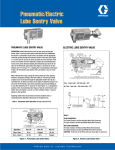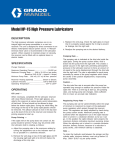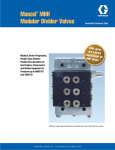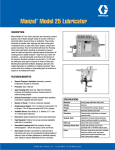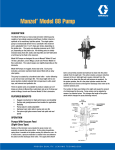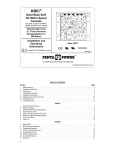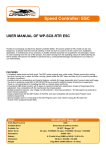Download Graco Manzel Lube Line Alert User's Manual
Transcript
Manzel Lube Line Alert ® OPERATION ELECTRIC CIRCUITRY The alert can be used with any lubrication system to indicate low, intermittent or steady flow. Air in any amount cannot be tolerated. For maximum protection connect the alert in the lubricant line as close to the terminal point as possible. The alert will detect flow or lack of low up to and through it, but not beyond it. The alert should not be mounted near strong magnetic fields, such as large motors, since they may adversely affect the permanent magnet or the magnetically actuated switch. The lead wires from the switch are readily available through the 1/2" NPT conduit connection for wiring into a suitable alarm or other circuit to handle electrical loads up to the rated switch capacity. One alert per pump will warn of flow stoppage for any reason, including lack of lubricant in the reservoir, shaft rotation stoppage, broken lubricant lines, contamination under pump valves or worn plungers. A single lube line alert per lubricator compartment on an active pump will warn of lack of lubricant in the reservoir, or shaft rotation stoppage. It will warn of a broken lubricant line, contamination under the pump check valve, or a worn plunger on the individual pump on which the alert is mounted. A single lube line alert per lubricator compartment on a special spare pump having a shortened pump suction tube and returns the flow directly to the reservoir, will warn of shaft rotation stoppage or low lubricant level in the reservoir before the active pumps are out of oil. Note: Cannot be used with Manzel Model 25 Lubricator. INSTALLATION Cut the lubricant line as close to the point of lubrication as practical. Extreme care is needed to eliminate all dirt and lint. Install the alert using caution to get proper flow direction, as shown on the name plate. CHECK VALVES Check valves should be used if the alert is going to be connected: • • Directly down stream** of a lubricator pumping unit. Directly up stream* of a terminal check valve of lubrication point feeding a pulsating pressure source. • When a rupture relief or vent is directly up stream of the alert. That is, there is no check valve or divider valve between the alert and the relief or vent. • Any system where the alert could be subjected to a sudden pressure or flow reversal. Check valves are not necessarily required if the alert is in a lubrication system: • • • Between the lube meter and divider valve. Between sets of divider valves. Between a pump manifold which has inlet check valves and no rupture relief and a lube meter or set of divider valves. 7/16-20 NF straight thread O-ring check valves and tube fittings are available for various tubing and pipe thread sizes. See specification sheet bulletin No. 54000 for connection. For the normally open (NO) switch position, multiple alerts should be wired in series or through separate circuits to provide fail-safe circuitry. Note: The loose cover must be assembled over the exposed machined face of the alert hydraulic body for proper Underwriters Laboratory listing. For normally closed (NC) switch position, multiple alerts should be wired in parallel or through separate circuits. Note: Automatic start-up and shutdown circuits will require the use of a time delay relay to lock out the alert circuit during start-up. A start-up delay time of approximately sixty (60) seconds or longer is required on some installations. Caution: To reduce the risk of ignition of hazardous atmospheres conduit runs must have a sealing fitting connected with 18 inches of the enclosure. ALERT ADJUSTMENT Check the actual installation by operating the system. If the alert fails to energize the circuit or continuously cuts in and out, see Troubleshooting. If, when the system is shut down, the delay time (time from flow failure to indication) is too long, the delay time can be reduced by adjusting the switch housing body towards outlet. Adjustment should be made in small increments, about 1/32" at a time. The final adjustment should be checked out several times, since the total time delay is dependent on the physical location of the inner parts of the alert at the time of the flow stoppage. Excessive adjustment of the alert can result in failure to energize the circuit. If a longer or shorter time delay is needed than can be obtained with the switch body adjustment, see Troubleshooting. CONTAMINATION CONTROL Alerts must be cleaned periodically. The frequency depends on the cleanliness of the installation. Remove the hydraulic body from the lubricant line, remove the inlet plug and tap the O-ring, bushing, plunger magnet, and spring out through the inlet connection. Flush and blow out all the passages. Wipe the magnet free of any iron dust. Do not place the magnet on or near iron or steel. This may cause some demagnetization, and affect the operation of the switch on reassembly. Make sure the plunger is oriented in the bushing the same as in the original assembly. Note: The plungers and bushing are tested in matched sets at the factory. DO NOT INTERCHANGE WITH OTHER PLUNGERS AND BUSHINGS. *Up Stream - toward the pump or supply source. **Down stream - toward the outlet or terminal point. TROUBLESHOOTING When contacting the Distributor, please specify delay code, oil viscosity, operating temperature (ambient and maximum differential), flow rate (cc/ minute or drops/minute), pumping frequency, operating pressure, and type of difficulty such as listed in II, III or IV following. I. Delay Code 1. 2. 3. Delay Code numbers are stamped in the left hand blue area of the name plate, above model number stamping space. The numbers are the time delays in seconds (time from flow failure to signal). The top number is for NO circuit and the bottom number of the NC circuit. This time delay in seconds is the delay time this unit had during its production test. This production test is done under strict specifications, i.e., oil viscosity held at a specific temperature, flow rate, pump strokes per minute, etc. The numbers are stamped on the assemblies to be used as a base reference point only. They are not the time delays (time from flow failure to signal) that customers will get on their actual installations. Operating conditions will vary widely from those of the specific production test specifications. II. Failure to Actuate Circuit 1. 2. 3. 4. 5. Check flow from the lubricant line beyond the alert. If no flow occurs, check the lubricator pump unit and lubricant line for trouble. If there is the required flow Check the switch body adjustment on the hydraulic body. The NC or NO mark on the hydraulic should be opposite the “0” mark on the switch body. The “0” is the point at which this switch activated based testing at the time of manufacture and is a reference point only for this switch. Actual oil viscosity, flow rates and oil temperature will cause shutdown time to vary within a range of 60 to 180 seconds. It may be necessary to move the switch body up or down to obtain the desired shutdown time based on actual operating parameters. If the above two check out and the circuit still does not actuate, check the dimension of the adjustment screw from the outlet end of the alert. As shipped from the factory, this dimension should be 17/32". To increase the delay time (time from flow failure to signal), back the screw out not more than 1/4 turn at a time. This screw has a 20 pitch thread, so each full turn backs the screw out .050 inches. If the alert does not actuate with the required flow rate, or if it flashes and cannot be adjusted as above, remove the outlet fitting and spring adjusting screw. Replace the original spring with the lighter spring, and reset the screw to 17/32". If the above procedures fail to correct the difficulty, check the delay code: a. If the delay code is low (example: 65), replace the unit with one having a higher delay code (example: 120). b. If the delay code is high (example: 120), and the delay time (time from flow failure to signal) is too long, replace the unit with one having a lower delay code (example: 70-90). III. Flashing or Sporadic Actuation of Circuit 1. This can be caused by the flow rate being too low, the frequency between pump cycles being too long, or the fluid viscosity being too low (normally due to high temperature). To overcome the above, see Section II. C or II. D. IV. Switch or Circuit Failures 1. 2. If this trouble is suspected; a. Remove the four switch body bolts. b. Slide the switch body back and forth across the face of the hydraulic body. This should cause the test light or circuit to go on or off. c. If the test light or circuit does not flash on or off, check the circuitry. If the circuit is satisfactory, replace the switch body. The switch contacts are probably welded closed due to overload. The new switch body will not have the "O" line. This can be established by: a. Oil flow to the alert must be stopped, and the alert magnet and plunger must be at a no flow position. b. With the circuit or test light energized, place the switch body part way on the lower portion of the hydraulic body. c. Slide the switch body along the hydraulic face until the test light goes on. d. Move the switch body 3/64" beyond the point where the light goes on. Mark the "O" Line opposite the NC line. The end of the switch housing must be flush or slightly above the end of the hydraulic body. If necessary, turn the switch body end over end to accomplish this. e. After checking the NC - "O" position to orient the switch body correctly, slide the switch body along the hydraulic body until the test light goes out. f. Move the switch body 3/64" beyond the point where the light goes off. g. The "O" line on the switch body should be opposite the NO line. If they do not line up, but the NO line is within 1/64" above the "O" line, it can be used as the NO- "O" line. If it is more than the 1/64" above the "O" line, then the original NO line must be blocked out and a new NO line established on the hydraulic body opposite the "O" line on the switch housing. h. Operate the system several times with the new setting to double check the delay time and proper switch action. All written and visual data contained in this document are based on the latest product information available at the time of publication. Graco reserves the right to make changes at any time without notice. Contact us today! To receive product information or talk with a Graco representative, call 800-533-9655 or visit us online at www.graco.com. ©2006-2009 Graco Inc. Form No. L45370 Rev. B 3/09 Printed in U.S.A. All other brand names or marks are used for identification purposes and are trademarks of their respective owners. All written and visual data contained in this document are based on the latest product information available at the time of publication. Graco reserves the right to make changes at any time without notice.


